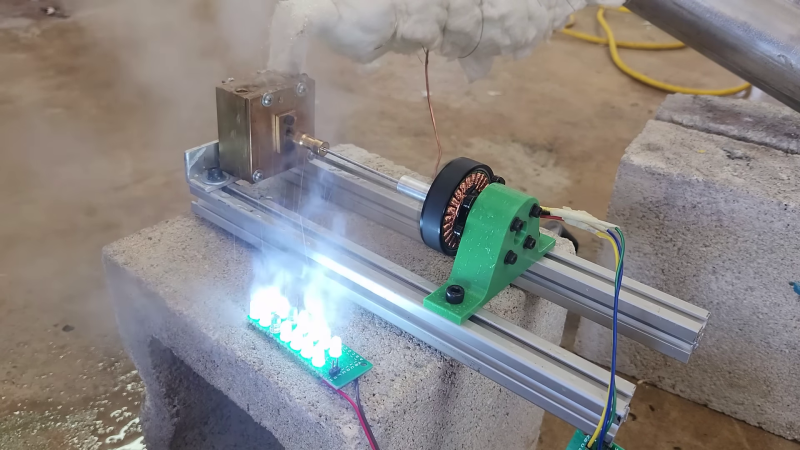Steam turbines have helped drive a large chunk of our technological development over the last century or so, and they’ll always make for interesting DIY. [Hyperspace Pirate] built a small turbine and boiler in his garage, turning fire into flowing electrons, and learning a bunch in the process.
[Hyperspace Pirate] based the turbine design on 3D printed Pelton-style turbines he had previously experimented with, but milled it from brass using a CNC router. A couple of holes had to be drilled in the side of the rotor to balance it. The shaft drives a brushless DC motor to convert the energy from the expanding steam into electricity.
To avoid the long heat times required for a conventional boiler, [Hyperspace Pirate] decided to use a flash boiler. This involves heating up high-pressure water in a thin coil of copper tube, causing the water to boil as it flows down the tube. To produce the high-pressure water feed the propane tank for the burner was also hooked up to the water tank to pressurize it, removing the need for a separate pump or compressed air source. This setup allows the turbine to start producing power within twelve seconds of lighting the burner — significantly faster than a conventional boiler.
Throughout the entire video [Hyperspace Pirate] shows his calculation for the design and tests, making for a very informative demonstration. By hooking up a variable load and Arduino to the rectified output of the motor, he was able to measure the output power and efficiency. It came out to less than 1% efficiency for turning propane into electricity, not accounting for the heat loss of the boiler. The wide gaps between the turbine and housing, as well as the lack of a converging/diverging nozzle on the input of the turbine are likely big contributing factors to the low efficiency.
Like many of his other projects, the goal was the challenge of the project, not practicality or efficiency. From a gyro-stabilized monorail, to copper ingots from algaecide and and a DIY cryocooler, he has sure done some interesting ones.















Could the results be different if the Pelton was switched out for something more suited to steam? Isn’t the Pelton an impulse turbine, responding to mass?
@Mike said: “Could the results be different if the Pelton was switched out for something more suited to steam? Isn’t the Pelton an impulse turbine, responding to mass?”
Yes, the Pelton turbine is an Impulse turbine where the nozzle (or nozzles) is/are fixed with respect to the rotor (or Prime Mover). The Pelton turbine (an Impulse turbine) does not require a casement around the rotor. A Reaction turbine (such as a Francis turbine) has a rotor that is propelled by the working fluid as it spins, so a rotor casement is typically required with a reaction turbine. When the working fluid is steam or water, a reaction turbine is usually more efficient than an impulse turbine. [1][2][3] In this case [Hyperspace Pirate] could simply inject the steam under pressure through the rotor’s hub, then the steam would propel the rotor directly as it escapes.
References:
[1] Turbine – Theory of operation
https://en.wikipedia.org/wiki/Turbine#Theory_of_operation
[2] Pelton Wheel (Impulse turbine)
https://en.wikipedia.org/wiki/Pelton_wheel
[3] Francis Turbine (Reaction turbine)
https://en.wikipedia.org/wiki/Francis_turbine
Or they could have skipped the Pelton and Francis liquid water turbines and gone for a steam design! But that’s a pretty complex build, this is certainly good for demonstrative purposes
This makes me wonder if solar thermal powersats might wind up better than PVs, with less acreage:
https://techxplore.com/news/2024-05-scientists-generate-1000c-solar-power.amp
Maybe Liquid Metal?
Is this an AI comment? Because it just tickles my “this was written bei an LLM” detector.
Probably, but so what? I find that the more I use AI to text generation the more disciplined and sophisticated my own writing becomes. Which is no mean feat given I’m one step up from a lysdexic idibbering giot.
Stares hard at his Mammods
Really good video presentation.
Awesome pacing and word/information density, good humorous injection.
Loved the burnt up red vinyl on the alligator clip.
All good, untill you run out of water.
Has anyone built a steam based computer? Should be possible.
Steam turbines in nuclear plant issues?
“Ten years after use, the surface of a spent fuel assembly
releases 10,000 rem/hr of radiation, far greater than the
fatal whole-body dose for humans of 500 rem received all at once.”
“The dose of radiation expected to cause death to 50 percent of
an exposed population within 30 days (LD 50/30).
Typically, the LD 50/30 is in the range from 400 to 450 rem
(4 to 5 sieverts) received over a very short period.”
“how many gallons of water used to produce 1 kwh in a data center?.
2 gallons”
Before 3d printing and Arduino I build a steam turbine from a juice can lid with a juice can for a boiler. Efficiency was zero since there was no generator. Can’t help but wonder what a coil and pm would have generated.
Real turbines are multi stage with a condenser at the end to complete the heat cycle. Don’t know what the efficiency of the turbine itself. Fossil plants get around 30 percent overall.
Pelton and Francis turbines developed and still.used for hydro plants. Charles Parsons developed multi-stage reaction steam turbine prime mover circa 1890 for marine use, later electric generation. General Electric and others bought rights to Curtis turbine, an impulse design. Reaction turbines used about 40 stages of steam expansion, whereas impulse turbines used about half as many. Efficiencies of 70% to 90% of available energy possible. Battle continues of which is more efficient. Overall thermal efficiency of nuclear or fossil steam plant tupically 30% to 40%, comparable to good diesel and gas engines. Best heat engine efficiency is combined cycle plant with gas turbine and steam turbine, up to 64% effieient.
David Smith
Retired utility engineet